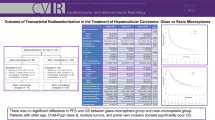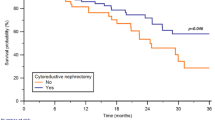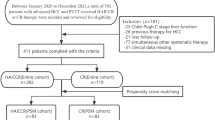Abstract
Background
Clinical benefits of presurgical axitinib therapy for renal cell carcinoma (RCC) extending into the inferior vena cava (IVC) remain unclear. We aimed to investigate surgical benefits and pathological antitumor effects of presurgical axitinib therapy for RCC with IVC thrombus.
Methods
Of 56 consecutive RCC patients with IVC thrombus between January 1994 and December 2016, 41 patients who underwent radical nephrectomy (RN) were categorized as upfront RN (Upfront group) or presurgical axitinib followed by RN (Presurgical group). We retrospectively evaluated safety, radiologic tumor responses, and Ki-67 proliferation index before and after axitinib administration in the Presurgical group. Surgical outcomes, postoperative complications, and fibrosis within the IVC thrombus were compared between the Upfront and Presurgical groups.
Results
The number of patients in the Upfront and Presurgical groups was 31 and 10, respectively. Major presurgical axitinib-related adverse events were grade 2 or 3 hypertension (50%). The median radiological tumor response in the renal tumor, IVC thrombus length, and IVC thrombus volume were −19%, −21 mm, and −54%, respectively. The fibrosis within the IVC thrombus was significantly higher in the Presurgical group (10%) than in the Upfront group (3.4%). The Ki-67 proliferation index was significantly decreased in RN specimens (7.3%) versus needle biopsy specimens (23%) in the Presurgical group. Blood loss and operative duration were significantly lower and shorter, respectively, in the Presurgical group than in the Upfront group.
Conclusions
Presurgical axitinib therapy enhanced tumor reduction accompanied by fibrosis and may contribute to surgical risk reduction for selected patients.



Similar content being viewed by others
References
Karam JA, Devine CE, Urbauer DL et al (2014) Phase 2 trial of neoadjuvant axitinib in patients with locally advanced nonmetastatic clear cell renal cell carcinoma. Eur Urol 66(5):874–880. doi:10.1016/j.eururo.2014.01.035
Thomas AA, Rini BI, Lane BR et al (2009) Response of the primary tumor to neoadjuvant sunitinib in patients with advanced renal cell carcinoma. J Urol 181(2):518–523. doi:10.1016/j.juro.2008.10.001 (discussion 523)
Cowey CL, Amin C, Pruthi RS et al (2010) Neoadjuvant clinical trial with sorafenib for patients with stage II or higher renal cell carcinoma. J Clin Oncol 28(9):1502–1507. doi:10.1200/jco.2009.24.7759
Rini BI, Garcia J, Elson P et al (2012) The effect of sunitinib on primary renal cell carcinoma and facilitation of subsequent surgery. J Urol 187(5):1548–1554. doi:10.1016/j.juro.2011.12.075
Kondo T, Hashimoto Y, Kobayashi H et al (2010) Presurgical targeted therapy with tyrosine kinase inhibitors for advanced renal cell carcinoma: clinical results and histopathological therapeutic effects. Jpn J Clin Oncol 40(12):1173–1179. doi:10.1093/jjco/hyq150
Cost NG, Delacroix SE Jr, Sleeper JP et al (2011) The impact of targeted molecular therapies on the level of renal cell carcinoma vena caval tumor thrombus. Eur Urol 59(6):912–918. doi:10.1016/j.eururo.2011.02.032
Sassa N, Kato M, Funahashi Y et al (2014) Efficacy of pre-surgical axitinib for shrinkage of inferior vena cava thrombus in a patient with advanced renal cell carcinoma. Jpn J Clin Oncol 44(4):370–373. doi:10.1093/jjco/hyu014
Yuki H, Kamai T, Kubota K et al (2014) Axitinib for preoperative downstaging of renal cell carcinoma with sarcomatoid differentiation and direct invasion of the duodenum and inferior vena cava: a case report. Onco Targets Ther 7:289–295. doi:10.2147/ott.s58089
Komatsubara M, Yamazaki M, Fujisaki A et al (2016) Tumor thrombus of renal cell carcinoma extending into the inferior vena cava, ovarian vein, and ureter treated with neoadjuvant axitinib. Urology 95:e3–e4. doi:10.1016/j.urology.2016.05.057
Schrader AJ, Steffens S, Schnoeller TJ et al (2012) Neoadjuvant therapy of renal cell carcinoma: a novel treatment option in the era of targeted therapy? Int J Urol 19(10):903–907. doi:10.1111/j.1442-2042.2012.03065.x
Bigot P, Fardoun T, Bernhard JC et al (2014) Neoadjuvant targeted molecular therapies in patients undergoing nephrectomy and inferior vena cava thrombectomy: is it useful? World J Urol 32(1):109–114. doi:10.1007/s00345-013-1088-1
Ujike T, Uemura M, Kawashima A et al (2016) Clinical and histopathological effects of presurgical treatment with sunitinib for renal cell carcinoma with inferior vena cava tumor thrombus at a single institution. Anticancer Drugs 27(10):1038–1043. doi:10.1097/cad.0000000000000422
Ljungberg B, Bensalah K, Bex A et al (2016) Guidelines on renal cell carcinoma. http://uroweb.org/wp-content/uploads/10-Renal-Cell-Carcinoma_LR1.pdf. Accessed 20 Mar 2017
Charlson M, Szatrowski TP, Peterson J et al (1994) Validation of a combined comorbidity index. J Clin Epidemiol 47(11):1245–1251
Hatakeyama S, Yoneyama T, Hamano I et al (2013) Prognostic benefit of surgical management in renal cell carcinoma patients with thrombus extending to the renal vein and inferior vena cava: 17-year experience at a single center. BMC Urol 13:47. doi:10.1186/1471-2490-13-47
Therasse P, Arbuck SG, Eisenhauer EA et al (2000) New guidelines to evaluate the response to treatment in solid tumors. European Organization for Research and Treatment of Cancer, National Cancer Institute of the United States, National Cancer Institute of Canada. J Natl Cancer Inst 92(3):205–216. doi:10.1093/jnci/92.3.205
Koie T, Ohyama C, Okamoto A et al (2013) Presurgical therapy with axitinib for advanced renal cell carcinoma: a case report. BMC Res Notes 6:484. doi:10.1186/1756-0500-6-484
Rini BI, Plimack ER, Takagi T et al (2015) A phase II study of pazopanib in patients with localized renal cell carcinoma to optimize preservation of renal parenchyma. J Urol 194(2):297–303. doi:10.1016/j.juro.2015.03.096
Hutson TE, Lesovoy V, Al-Shukri S et al (2013) Axitinib versus sorafenib as first-line therapy in patients with metastatic renal-cell carcinoma: a randomised open-label phase 3 trial. Lancet Oncol 14(13):1287–1294. doi:10.1016/s1470-2045(13)70465-0
Hosogoe S, Hatakeyama S, Kusaka A et al (2017) Contrast media enhancement reduction predicts tumor response to presurgical molecular-targeting therapy in patients with advanced renal cell carcinoma. Oncotarget. doi:10.18632/oncotarget.17930
Chery LJ, Karam JA, Wood CG (2016) Cytoreductive nephrectomy for metastatic renal cell carcinoma. Clin Adv Hematol Oncol 14(9):696–703
Acknowledgements
We thank Yuki Fujita, Yukie Nishizawa, Kaname Higuchi, Satomi Sakamoto, and Masako Isono for their invaluable help with the data and sample collection.
Author information
Authors and Affiliations
Corresponding author
Ethics declarations
Source of funding
This work was supported by a Grant-in-Aid for Scientific Research (nos. 15H02563 15K15579, 17K11118, 17K11119, 17K16768, 17K16770, and 17K16771) from the Japan Society for the Promotion of Science.
Conflict of interest
The authors declare that they have no conflict of interest.
Research involving human participants and/or animals
All procedures performed in studies involving human participants were in accordance with the ethical standards of the institutional and/or national research committee and with the 1964 Helsinki declaration and its later amendments or comparable ethical standards.
Informed consent
For this type of study formal consent is not required. Pursuant to the provisions of the ethics committee and the ethic guideline in Japan, written consent was not required in exchange for public disclosure of study information in the case of retrospective and/or observational study using a material such as the existing documentation. The study information was open for the public consumption at http://www.med.hirosaki-u.ac.jp/~uro/html/IRB/IRBdoc.html.
About this article
Cite this article
Tanaka, Y., Hatakeyama, S., Hosogoe, S. et al. Presurgical axitinib therapy increases fibrotic reactions within tumor thrombus in renal cell carcinoma with thrombus extending to the inferior vena cava. Int J Clin Oncol 23, 134–141 (2018). https://doi.org/10.1007/s10147-017-1169-z
Received:
Accepted:
Published:
Issue Date:
DOI: https://doi.org/10.1007/s10147-017-1169-z




